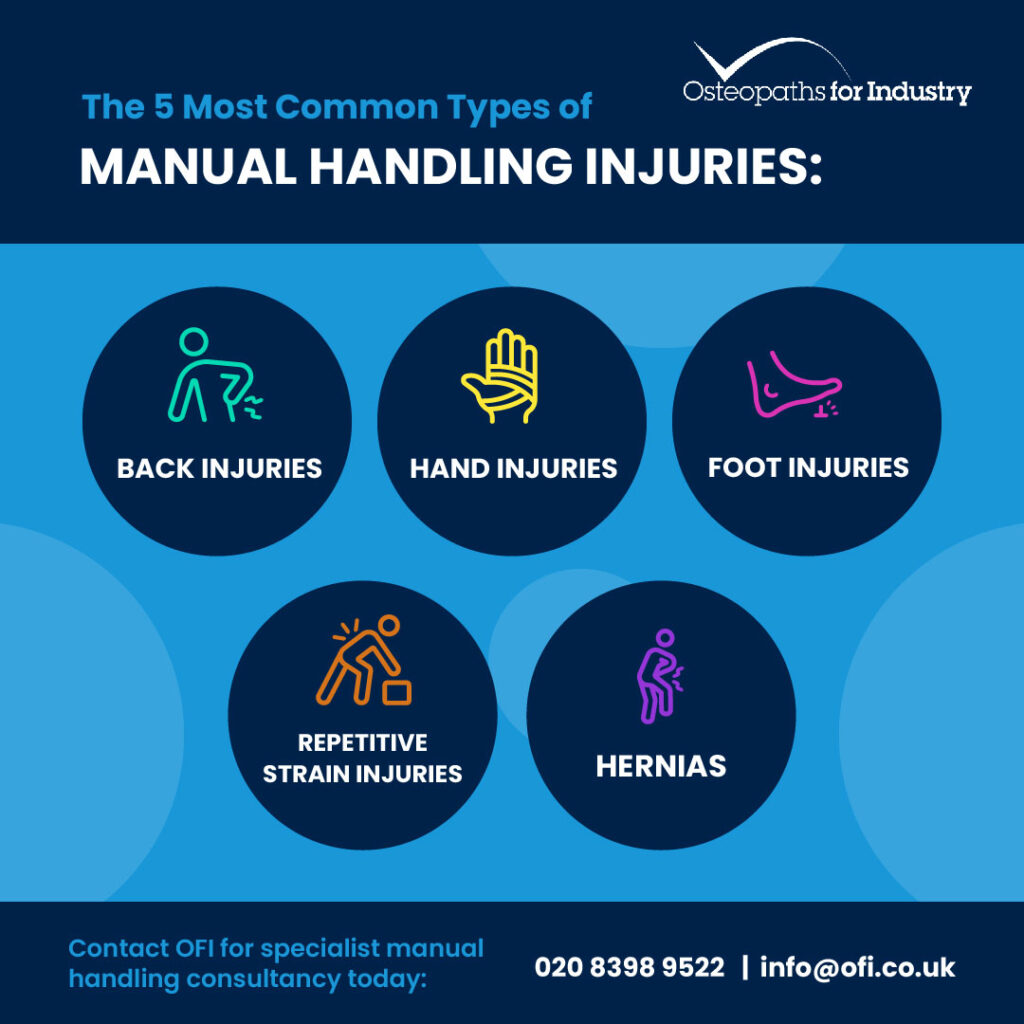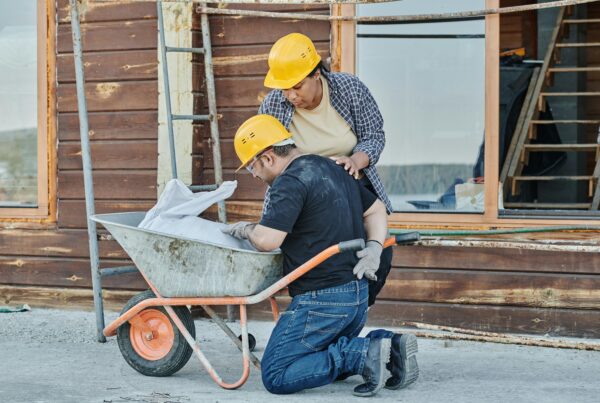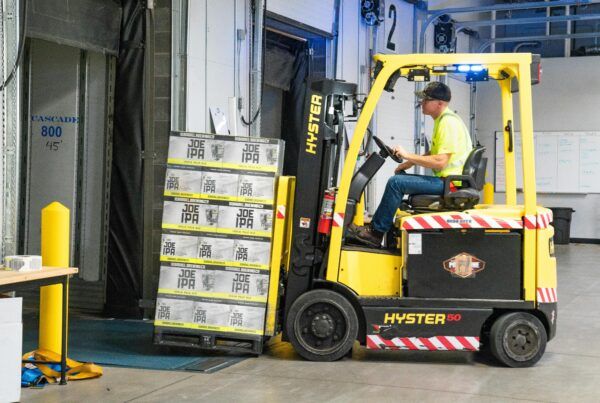While there was a decrease in workplace injuries from 2000 to 2020, in the three years since the COVID-19 pandemic, manual handling injuries in the workplace have stopped declining and begun once more to grow in number and frequency. This indicates that there is a need for both employers and employees to focus more on risk prevention measures.
The first step to prevention, however, is identifying and understanding the most likely forms of injury. In this post, we’ve compiled the five most common manual handling injuries, explained their causes, and outlined some examples of good handling habits that can aid in risk mitigation.

1. Back Injuries
While many forms of workplace injuries stem from manual handling, back injuries are by far the majority. In the UK, around 300,000 individuals annually experience back pain of varying degrees resulting from manual handling accidents. Back injuries can be debilitating, leading to extreme pain or temporary incapacity. These injuries can also become lifelong struggles for workers that can affect them for the rest of their lives. Back injuries are especially common in jobs that require lifting and carrying heavy loads, as incorrect techniques can easily cause strain in the back.
2. Hand Injuries
Other prevalent injuries in the workplace consist of those occurring to the hands. Hand injuries encompass a wide range of different painful injuries and conditions, including everything from broken/bruised fingers to muscle strains. These injuries typically occur when gripping and lifting bulky or unwieldy loads, especially if the loads lack proper handholds to support the fingers and palms. There are other causes, too, such as the temperature of the surface or the sharpness of its edges. These can lead to burns, cuts, and lacerations. Hand injuries are typically less chronic than those of the back but can be equally hazardous as they can often prevent employees from working or carrying out certain tasks for extended periods.
3. Foot Injuries
When performing manual handling tasks, the feet are crucial; they provide workers with a strong foundation that allows the full use of one’s leg and core strength. As such, the feet often suffer injuries, especially if workers fail to maintain a stable position when lifting. In addition to muscle strain while lifting, the feet are also at risk if a load is dropped or slips, which can result in crushing, bruising, or even breaking or fracturing bones. The risks are even higher if a worker is not wearing adequate shoes, so providing your staff with protective shoes is a must.
4. Hernias
Lifting heavy loads can result in the strain of stomach muscles, which, if it happens repeatedly, can lead to a hernia. A hernia is the abnormal exit of tissue or an organ internally, which can cause pain and difficulty in movement, greatly hindering a worker’s ability to perform tasks properly. Lack of proper manual handling training is the most common reason for hernias, as incorrect lifting techniques can put a worker at high risk. There are multiple types of hernias. However, they all result in general weakness of the body and extreme abdominal pain. Ageing workers are at a higher risk of hernias, so they must take special care when lifting.
5. Repetitive Strain Injuries
Repetitive Strain Injuries (RSI) refer to conditions where the muscles, tendons, or nerves in the body are overworked, leading to excessive pain. These injuries are typically caused by repeating a motion many times in succession, a major risk in fields such as manufacturing or construction that involve repeated handling tasks. The most common body areas for RSI are the shoulders, elbows, forearms, wrists, and hands. These areas typically face the most strain on the muscles and tendons while performing tasks like heavy lifting. The symptoms of RSI include:
- Discomfort and sensations resembling burning or throbbing.
- Tingling, pins-and-needles, or a numb feeling.
- Stiffness, weakness, or swelling.
- Muscle cramps.
- Challenges in gripping objects or forming a fist.
- Reduced range of motion in the impacted joint.
RSI may seem like a minor issue, but it can lead to severe loss of mobility and reduced productivity. It also heightens the risk of developing other disorders, such as tendonitis, carpal tunnel syndrome, tennis elbow, and more.
Prevention
In order to prevent all these injuries, reinforce good lifting habits with your staff. In addition to formal training, frequently remind workers to:
- Avoid stooping or twisting when lifting heavy loads
- Maintain a stable footing while executing handling tasks, keeping the feet shoulder width apart with good balance
- Maintain a good head position, ensuring visibility
- Avoid jerky movements
- Avoid overworking to prevent exhaustion
- Wear clothing (e.g., appropriate footwear) that provides protection and support
From the employers’ side, you should prioritise task design, avoiding overly heavy lifts by implementing machinery or reconfiguring tasks so that the heaviest loads do not need to be moved. Employers must also keep a keen eye on the nature of the load. Handling of overly heavy or awkwardly shaped loads should be avoided, mechanised, or done in a team so that the risk of injury is reduced for each member. In addition, be sure to provide thorough and comprehensive training to all employees involved in manual handling or display screen equipment work. It is imperative, for compliance and safety, for them to receive training from certified providers, such as OFI.
OFI can help you prevent these common workplace injuries. We provide in-depth manual handling training courses, as well as risk assessment and risk assessor training. If you’re unsure where to start, you can also contact us to for consultancy. Read more about how you can ensure a safe and productive workplace here!
In Summary
The resurgence of manual handling injuries in the UK post-pandemic highlights the need for increased awareness and preventative measures. Back injuries, hand injuries, foot injuries, hernias, and repetitive strain injuries represent the most common forms of workplace injury, with each having its own set of challenges that employers must tackle. Consistent training and awareness efforts which include instruction on proper lifting techniques, safer task design, and the use of PPE are essential in order to counteract these risks. Employers play a crucial role in creating a safe workplace by prioritising task design, avoiding overly heavy lifts, and providing comprehensive training to mitigate the risks associated with manual handling. Proactive measures contribute significantly to the workforce’s overall health, safety, and productivity.








